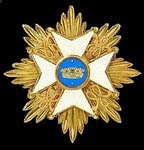Created 1749 from amalgamating regiments Arquebusiers de Grassin Fusiliers de la Morliere and the Volontaires Bretons. Composed of three brigades of 4 companies each, 2 of infantry of 40 men and 2 of cavalry of 20 men each, not including officers.
Divided into 2 regiments in 1757, the Volontaires de Flandres and Volontaires du Haynault, consisting of 6 companies each; the company was of 70 men, 40 infantry and 30 cavalry. By Ordonnance of 25th February 1758 each of the two regiments was increased to 600 men by adding 2 new companies and 5 mounted men to each of the 6 companies. Total was therefore 8 companies of 75 men each, 40 foot and 35 cavalry.
In 1762 the regiment was amalgamated with the Volontaires du Dauphiné and renamed the Légion de Flandre, which was disbanded in 1776.
The flags are variously described but I know of no contemporary depiction. Charrié says at the centre was a lion in natural colours from 1749-1762. But the lion of Flanders in heraldry was anciently depicted as a black rampant lion. I have therefore created 2 versions, one as described by Charrié (Variant 1) and one with the traditional heraldic Flanders lion (Variant 2).
Service (mostly from Kronoskaf as I have no independent history):
1757: Army of the Lower Rhine; July 26th battle of Hastenbeck with the vanguard which attacked the left flank of the Hanoverians in the woods
1758: In Clermont's Army; at the battle of Krefeld June 23rd then with the Army of the Lower Rhine under Contades and with Chevert's Corps which turned the allied left flank at the battle of Lutterberg October 10th
1759: Various advanced corps actions including being forced to retire into woods near Fritzlar by the advance of an allied corps on the 17th August
1760: Similar advance corps activity and then at the battle of Korbach as part of Saint Germain's detachment on July 10th, reaching the battlefield only after a forced march. From November 17th part of the garrison of Göttingen.
1761: 25th March mounted troops of the regiment along with those of other Volontaire units and the Orléans Dragoons under M. de Montchenu drove the allies out of the village of Mengsberg and then successfully attacked the allied rearguard.
1761: Part of the corps of Prince Xavier which was attacked by Luckner on July 13th and the French corps lost 150 prisoners. On August 15th as part of Caraman's Corps, and along with Nicolai Dragoons and Chamborant Hussars, it was part of a successful attack near Dringenberg on allied troops, taking 2 officers and 60 men prisoners. The Corps was attacked on August 18th by allied forces under the Hereditary Prince but retired in good order having lost 30 men and having taken about 30 prisoners.
1762: Army of the Upper Rhine under Soubise; June 24th battle of Wilhelmstahl. July 10th involved in an attack on allied troops at Uslar and took over 500 prisoners in the woods nearby. Eventually they were forced to retreat by the arrival of Luckner's Corps.
And this was the infantry uniform in the SYW:






















